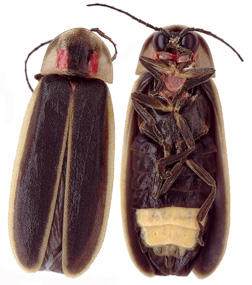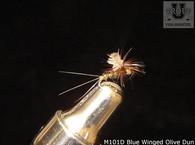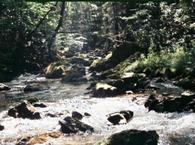
In the area of Elkmont Camopground in the Great Smokies National Park there will be the annual firefly magnificent fireworks on display in late May or early June. To have an opportunity to view this spectacular event you must apply to be entered in a sweepstakes since the viewing is limited. Visit the park's Synchronous Fireflies web page for additional information. In the meantime, read this fascinating information about the fireflies. MAP
Synchronous fireflies (Photinus carolinus) are one of at least 19 species of fireflies that live in Great Smoky Mountains National Park and one of only a few species in the world known to synchronize their flash patterns. This insects’ reproductive display occurs for a couple of weeks every year throughout its range (southern Appalachians), and is typically in late May or early June in the Elkmont area of the park.
During the peak firefly display period, the park organizes a shuttle service from Sugarlands Visitor Center to the Elkmont viewing area where a large population of synchronous fireflies occurs. Visitors who wish to view the fireflies must acquire a pass to park at the Sugarlands Visitor Center and ride a shuttle to the viewing area. The number of parking spaces is limited, as is the capacity of the shuttle system. During the 8-day shuttle operating period, the Elkmont area will be closed at night to all but the shuttle system and campers. Visit the park’s Synchronous Fireflies web page for additional information about the event.
Fireflies (also called lightning bugs) are beetles. They take from one to two years to mature from larvae, but will live as adults for only about 21 days. While in the larval stage, the insects feed on snails and smaller insects. Once they transform into their adult form, they do not eat.
Their light patterns are part of their mating display. Each species of firefly has a characteristic flash pattern that helps its male and female individuals recognize each other. Most species produce a greenish-yellow light; one species has a bluish light. The males fly and flash and the usually stationary females respond with a flash. Peak flashing for synchronous fireflies in the park is normally within a two-week period in late May to mid-June.
The production of light by living organisms is called bioluminescence. Fireflies are a good example of an organism that bioluminesces, but there are others as well, such as certain species of fungus, fish, shrimp, jellyfish, plankton, glowworms, gnats, snails, and springtails.
Bioluminescence involves highly efficient chemical reactions that result in the release of particles of light with little or no emission of heat. Fireflies combine the chemical luciferin and oxygen with the enzyme luciferase in their lanterns (part of their abdomens) to make light. The light produced is referred to as a "cold" light, with nearly 100% of the energy given off as light. In contrast, the energy produced by an incandescent light bulb is approximately 10% light and 90% heat.
No one is sure why the fireflies flash synchronously. Competition between males may be one reason: they all want to be the first to flash. Or perhaps if the males all flash together they have a better chance of being noticed, and the females can make better comparisons.The fireflies do not always flash in unison. They may flash in waves across hillsides, and at other times will flash randomly. Synchrony occurs in short bursts that end with abrupt periods of darkness.





